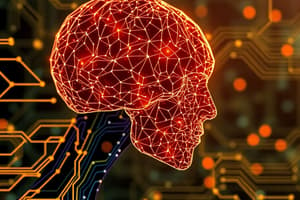Podcast
Questions and Answers
What is the main objective of developing a learning algorithm in the context of 'Learning to Learn'?
What is the main objective of developing a learning algorithm in the context of 'Learning to Learn'?
- To develop a model that can only learn from a single example
- To develop a model that can only perform a single task
- To develop a model that can only adapt to a single domain
- To develop a model that can generalize from a set of tasks to quickly learn new tasks with minimal additional data (correct)
What is 'Few-Shot Learning' in the context of 'Related Problems'?
What is 'Few-Shot Learning' in the context of 'Related Problems'?
- Learning tasks without any training examples
- Learning tasks where a large amount of data is available for training
- Learning tasks that require a large amount of computational resources
- Learning tasks where only a few examples are available for training (correct)
What is the key factor that determines the effectiveness of 'Transfer Learning'?
What is the key factor that determines the effectiveness of 'Transfer Learning'?
- The size of the source dataset
- The amount of computational resources available
- The similarity between the source and target tasks (correct)
- The type of model used for pretraining
What is the process of using knowledge from a source task to improve learning in a target task called?
What is the process of using knowledge from a source task to improve learning in a target task called?
What is 'Domain Adaptation' in the context of 'Related Problems'?
What is 'Domain Adaptation' in the context of 'Related Problems'?
What is the purpose of 'Pretraining and Finetuning' in the context of 'Transfer Learning'?
What is the purpose of 'Pretraining and Finetuning' in the context of 'Transfer Learning'?
What is 'Zero-Shot Learning' in the context of 'Related Problems'?
What is 'Zero-Shot Learning' in the context of 'Related Problems'?
What is the main idea behind 'Learning to Learn'?
What is the main idea behind 'Learning to Learn'?
What is the primary goal of meta learning?
What is the primary goal of meta learning?
Which of the following is a key application of meta learning?
Which of the following is a key application of meta learning?
What is the main challenge in developing meta learning algorithms?
What is the main challenge in developing meta learning algorithms?
What is the primary advantage of using foundation models?
What is the primary advantage of using foundation models?
Which meta learning algorithm optimizes for a model initialization that can be fine-tuned quickly with a few gradient steps?
Which meta learning algorithm optimizes for a model initialization that can be fine-tuned quickly with a few gradient steps?
What is the primary goal of prototypical networks?
What is the primary goal of prototypical networks?
Which of the following is not a core concept of meta learning?
Which of the following is not a core concept of meta learning?
What is the primary difference between MAML and Reptile?
What is the primary difference between MAML and Reptile?
What is the primary goal of multi-task learning?
What is the primary goal of multi-task learning?
What is the main challenge in domain adaptation?
What is the main challenge in domain adaptation?
What is the objective of meta-learning?
What is the objective of meta-learning?
What is the purpose of inner loop optimization in meta-learning?
What is the purpose of inner loop optimization in meta-learning?
Which of the following is a benefit of multi-task learning?
Which of the following is a benefit of multi-task learning?
What is domain adaptation used for?
What is domain adaptation used for?
Which of the following is an example of a meta-learning algorithm?
Which of the following is an example of a meta-learning algorithm?
What is the purpose of evaluation techniques in few-shot learning?
What is the purpose of evaluation techniques in few-shot learning?
What is the goal of Outer Loop Optimization?
What is the goal of Outer Loop Optimization?
What is the primary function of Recurrent Meta-Learning?
What is the primary function of Recurrent Meta-Learning?
What is the primary advantage of Model-Agnostic Meta-Learning (MAML)?
What is the primary advantage of Model-Agnostic Meta-Learning (MAML)?
What is the purpose of the inner loop optimization in MAML?
What is the purpose of the inner loop optimization in MAML?
What is hyperparameter optimization?
What is hyperparameter optimization?
What is the primary goal of combining meta-learning with curriculum learning?
What is the primary goal of combining meta-learning with curriculum learning?
What is the purpose of the meta-gradient in MAML?
What is the purpose of the meta-gradient in MAML?
What is the primary advantage of using RNNs in Recurrent Meta-Learning?
What is the primary advantage of using RNNs in Recurrent Meta-Learning?
What is the primary advantage of meta-learning and transfer learning?
What is the primary advantage of meta-learning and transfer learning?
What is the main difference between meta-learning and multi-task learning?
What is the main difference between meta-learning and multi-task learning?
How does zero-shot learning identify classes it has not seen before?
How does zero-shot learning identify classes it has not seen before?
What is pretraining in the context of transfer learning?
What is pretraining in the context of transfer learning?
What is the main goal of meta-learning?
What is the main goal of meta-learning?
What is transfer learning?
What is transfer learning?
What can be considered hyperparameters in a model?
What can be considered hyperparameters in a model?
What is the key benefit of using meta-learning?
What is the key benefit of using meta-learning?
Flashcards are hidden until you start studying
Study Notes
Meta Learning
- Meta learning, or learning to learn, is an approach where models are designed to learn new tasks more efficiently by leveraging knowledge from previous tasks.
- The key idea is to train models in a way that they can quickly adapt to new tasks with minimal data and computational resources.
- Applications of meta learning include few-shot learning, reinforcement learning, and domain adaptation.
Core Problem
- The core problem in meta learning is developing algorithms that can efficiently learn new tasks by leveraging prior knowledge, thus reducing the need for extensive training data and computational resources.
- The challenge is to ensure that the model can generalize well to new tasks that were not seen during training.
Core Algorithms
- Model-Agnostic Meta-Learning (MAML): Optimizes for a model initialization that can be fine-tuned quickly with a few gradient steps.
- Reptile: A simpler alternative to MAML that performs meta optimization through repeated stochastic gradient descent steps.
- Prototypical Networks: Uses metric learning to classify new examples based on their distance to prototype representations of each class.
- R2-D2: Rapidly learning representations for reinforcement learning tasks.
Foundation Models
- Large pre-trained models, such as GPT, BERT, or ResNet, serve as the basis for various downstream tasks.
- Advantages of foundation models include significantly reducing training time and required data for new tasks through transfer learning and fine-tuning.
Learning to Learn
- Learning to learn is the process where an agent or model improves its learning efficiency over time by leveraging past experiences from multiple tasks.
- The objective is to develop a learning algorithm that can generalize from a set of tasks to quickly learn new tasks with minimal additional data.
Related Problems
- Few-Shot Learning: Learning tasks where only a few examples are available for training.
- Zero-Shot Learning: Learning tasks without any training examples, typically relying on related knowledge or descriptions.
- Domain Adaptation: Adapting a model trained in one domain to perform well in a different, but related domain.
Transfer Learning and Meta-Learning Agents
- Transfer Learning: The process of using knowledge from a source task to improve learning in a target task.
- Task Similarity: The effectiveness of transfer learning depends on the similarity between the source and target tasks.
- Pretraining and Fine-tuning: Pretraining a model on a large source dataset and fine-tuning it on the target dataset.
Multi-task Learning
- Multi-task Learning: Simultaneously training a model on multiple tasks to leverage shared representations and improve generalization across tasks.
- Approach: Involves sharing weights between tasks to enable the model to learn common features.
- Benefits: Improves learning efficiency and performance on individual tasks by leveraging commonalities.
Domain Adaptation
- Domain Adaptation: The process of adapting a model trained on a source domain to perform well on a target domain with different characteristics.
- Challenges: Handling distribution shifts and ensuring that the model generalizes well to the target domain.
- Techniques: Includes adversarial training, domain adversarial neural networks (DANN), and transfer component analysis (TCA).
Meta-Learning Algorithms
- Deep Meta-Learning Algorithms: Advanced algorithms that use deep learning techniques to implement meta-learning.
- Examples: MAML, Reptile, Meta-SGD.
- Applications: Image classification, reinforcement learning, and NLP.
Inner and Outer Loop Optimization
- Inner Loop Optimization: The process of adapting the model parameters for a specific task during meta-training.
- Goal: Minimize the loss on a given task using a few gradient steps.
- Outer Loop Optimization: The process of updating the meta-parameters based on the performance across multiple tasks.
- Goal: Optimize the initialization or hyperparameters to improve performance on unseen tasks.
Recurrent Meta-Learning
- Recurrent Meta-Learning: Using recurrent neural networks (RNNs) to capture dependencies between tasks and improve the learning process.
- Approach: RNNs process sequences of tasks and learn to adapt based on previous tasks.
Model-Agnostic Meta-Learning (MAML)
- MAML: A meta-learning algorithm that optimizes for a model initialization that can be quickly adapted to new tasks with few gradient steps.
- Algorithm: Initializes parameters, performs inner loop optimization, computes meta-gradient, and updates parameters.
Hyperparameter Optimization
- Hyperparameter Optimization: The process of tuning the hyperparameters of a learning algorithm to improve its performance.
- Techniques: Grid search, random search, Bayesian optimization.
Meta-Learning and Curriculum Learning
- Meta-Learning and Curriculum Learning: Combining meta-learning with curriculum learning to gradually increase the complexity of tasks and improve the learning process.
Studying That Suits You
Use AI to generate personalized quizzes and flashcards to suit your learning preferences.




